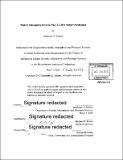Pluto's atmosphere from the May 22, 2011 stellar occultation
Author(s)
Sallum, Stephanie E
DownloadFull printable version (3.700Mb)
Other Contributors
Massachusetts Institute of Technology. Department of Earth, Atmospheric, and Planetary Sciences.
Advisor
Richard P. Binzel.
Terms of use
Metadata
Show full item recordAbstract
This paper reports the observations and atmospheric fitting results from the May 22, 2011 stellar occultation by Pluto. Of the nine sites across the United States that attempted to observe the event, three obtained light curves at the predicted midtime without being clouded out. Simultaneous fitting of these three light curves utilizing a model fully detailed in Elliot and Young [1992] resulted in a best fit half-light radius of 1309 ± 25 km, a calculated temperature of 94 ± 4 K, and a calculated pressure scale height of 55 ± 2 km. These parameters, in the context of the previous occultations, reveal a trend in which Pluto's half-light radius has been increasing slightly since an initial dramatic increase between 1988 and 2002. While the pressure scale height has remained relatively constant, the temperature has decreased slightly over the recorded events. The changes in half-light radius agree with frost migration models in which Pluto's surface has a low thermal inertia [Hansen and Paige, 1996; Elliot et al., 2007], but further constraints on frost migration model parameters such as substrate and frost albedo, frost emissivity, and the supply of N2 require additional observations. The New Horizons spacecraft should encounter a dynamic atmosphere on Pluto during the scheduled fly by in 2015.
Description
Thesis: S.B., Massachusetts Institute of Technology, Department of Earth, Atmospheric, and Planetary Sciences, 2012. Cataloged from PDF version of thesis. Includes bibliographical references (pages 40-41).
Date issued
2012Department
Massachusetts Institute of Technology. Department of Earth, Atmospheric, and Planetary SciencesPublisher
Massachusetts Institute of Technology
Keywords
Earth, Atmospheric, and Planetary Sciences.